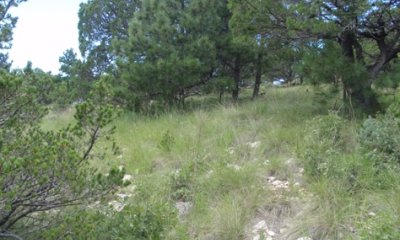
Limestone Mountain (South Aspect) 20-26" PZ
Scenario model
Current ecosystem state
Select a state
Management practices/drivers
Select a transition or restoration pathway
- Transition T1A More details
- Restoration pathway R2A More details
-
No transition or restoration pathway between the selected states has been described
Target ecosystem state
Select a state
State 1
High Frequency Fire State




Description
The reference community is the Ponderosa Pine-Pinyon-Juniper/Oak/Bluestem-Muhly Community. It is characterized by a dominance of ponderosa pine. Associated trees include pinyon pine, alligator juniper, oneseed juniper, and Gambel’s oak. Big bluestem, little bluestem, yellow indiangrass, Muhlenbergia species, and needlegrasses are common warm and cool-season grasses. The south facing aspect prevents closed canopy forest from occurring.
The Ponderosa Pine-Juniper/Oak/Bluestem-Muhly Community is a post-fire community in an early to mid successional stage. Most tree and shrub cover is reduced. Wavyleaf oak will be a part of this community since in rapidly resprouts following fires. Shade intolerant warm-season grasses and will dominated the herbaceous layer with scattered forbs.
Submodel
Description
The Ponderosa Pine-Pinyon-Juniper/Oak/Threeawn Community is characterized by a low cover of grasses and increased woody shrubs and trees such as juniper and pinyon pine. Unpalatable grasses are common. Other grasses composition will fluctuate depending on grazing intensity.
The Ponderosa Pine-Juniper/Oak/Threeawn Community is a post-fire community in an early to mid successional stage. Most tree and shrub cover is reduced with the exception of wavyleaf oak which rapidly resprouts following fires. Depending on fire severity, pinyon pine can be absent due to its fire sensitivity.
Submodel
Mechanism
With overgrazing and fire suppression, the High Frequency Fires will shift to the Low Frequency Fires.
Model keys
Briefcase
Add ecological sites and Major Land Resource Areas to your briefcase by clicking on the briefcase (![]() ) icon wherever it occurs. Drag and drop items to reorder. Cookies are used to store briefcase items between browsing sessions. Because of this, the number of items that can be added to your briefcase is limited, and briefcase items added on one device and browser cannot be accessed from another device or browser. Users who do not wish to place cookies on their devices should not use the briefcase tool. Briefcase cookies serve no other purpose than described here and are deleted whenever browsing history is cleared.
) icon wherever it occurs. Drag and drop items to reorder. Cookies are used to store briefcase items between browsing sessions. Because of this, the number of items that can be added to your briefcase is limited, and briefcase items added on one device and browser cannot be accessed from another device or browser. Users who do not wish to place cookies on their devices should not use the briefcase tool. Briefcase cookies serve no other purpose than described here and are deleted whenever browsing history is cleared.
Ecological sites
Major Land Resource Areas
The Ecosystem Dynamics Interpretive Tool is an information system framework developed by the USDA-ARS Jornada Experimental Range, USDA Natural Resources Conservation Service, and New Mexico State University.
